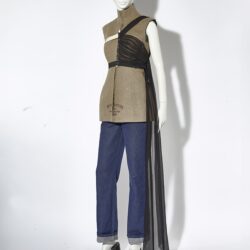Face Masks: across the past centuries and towards the next

In 2020, face masks infused our daily life to the speed of light, and set a different contemporary appreciation of such item, as it shoulders the double role of protecting and adorning. Because face masks pepper the past centuries, a throw-back to several key points in their history will unfold various considerations of this object through time, and highlight its complexities as well as it potentialities.
13th century : Holding one’s breath
The first traces of a mouth covering item, date back to the 13th-century and was reported by the merchant and writer, Marco Polo. It was said that at the time of the Yuan dynasty in China (1279-1368), silk scarves were used by the emperor’s servants to cover their mouth and nose, in order to prevent their breath from impacting the meals’ taste and smell.
The Venice Carnival : The identity makeover
Still a far cry from medical concerns, another example to be traced are the Venetian masks. In time of the Venice Carnival — very likely inaugurated in 1162 —, face masks licensed wearers to step out of convention and act freely away from judgement. Thus covering partly or entirely one’s identity, opened the door to all sorts of exuberant and feverish behaviours; The act of disguising aimed to hack reality, and nurtured cultural imagination. At the fall of the Venetian Republic in 1797 at the hands of Napoleon Bonaparte, the use of masks in daily life, was strictly forbidden, in reaction to what hiding and deceiving could imply.

16th century : A promotion of pale complexion
Made out of leather, dark velvet or silk, the 16th century full-face vizards, protected women from sunburn. As much functional as aesthetic, they aligned with the common belief that a pale complexion was a sign of moral purity, wealth and delicacy, and thereby fostered these contemporary beauty criteria.


17th century: The solemn emblem of the plague epidemic
In the midst of the 17th century, the “plague prevention costume” was invented and largely spread to prevent doctors from contagious patients of the raging and devastating plague epidemic. The physician Charles de Lorme reported that the mask featured a “nose half a foot long, shaped like a beak, filled with perfume with only two holes, one on each side near the nostrils”. In the 19th century, the germ theory had undermined the miasma theory — the belief reckoning hazardous particules in the air were responsible for most of the epidemic outbreaks — and shaped our contemporary understanding of medicine. Nowadays, the figure of the plague doctors, covered from head to toe, resonates with a symbolic and dreadful evocation of the past, and reminds of the outdated medical beliefs and practices of this gloomy period.

1918 : A new infestation rimes with a first democratisation
In the wake of the 20th century, precisely in 1918, the world got to face the ruthless influenza virus — a pandemic also known as the Spanish Flu. By this year, the germ theory had triggered a shift of perspective, and partook in the establishment of new sanitary practices towards contagious diseases: such as the extensive use of face masks by medical staff; But interestingly as well, for the first time, to be worn by masses in public space. Indeed, it was substantiated that masks protected as much from spreading the disease than catching the disease, and numerous public campaigns — mainly in the United States — supported the responsible measure to wear a mask. Signs covered streetcars’ doors threatening the so-called mask-slackers: “Wear a Mask or Go to Jail.”

The long way from silk to synthetic — and back to silk?
In 1918, medical researchers asserted in the Journal of the American Medical Association “A mask may be repeatedly washed and used indefinitely” as it was a mere layering of gauze and cotton fabric. However, from the 60s onward, synthetic materials, proved more efficient, imposed disposable masks as the norm — namely because these materials could not support a second sterilisation. Therefor, in the post-war boom, even the medical field was transformed by consumer culture: entitled the “Throwaway Living” by LIFE Magazine in 1955.
In 2020, surgical masks are a symbol of our collective dystopian experience and became part of our fashion system. A resumption of common interest in reusable masks — urged by a general trend to counter fast-fashion and such “Throwaway Living” — impulsed many fashion designers to react and create accordingly. Thus, masks are likely to be the new fashion item to tame and appropriate for the coming years, and they promise an interesting take on their history. An evolution to keep a close look on.




